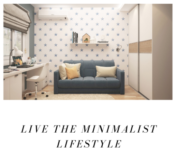Adopting a minimalist mindset is a conscious choice to simplify your life, declutter your surroundings, and focus on what truly matters. The purpose of this step-by-step guide is to provide you with practical tips and strategies to incorporate minimalism into your daily routine. It will help you eliminate distractions, reduce stress, and find contentment in a more meaningful and intentional way of living. By following this guide, you can start embracing a minimalist mindset and experience the benefits it brings to your life.
Understand the Concept of Minimalism
Define what minimalism means and why it is important:
To understand the concept of minimalism, let’s start by defining what it means. Minimalism is a lifestyle and mindset that focuses on simplicity, prioritizing what truly adds value to our lives and letting go of the excess. It is about intentionally choosing to live with less, both physically and mentally. Minimalism encourages us to declutter our physical space, get rid of unnecessary possessions, and simplify our daily routines to create more time, space, and freedom for the things that truly matter.
Adopting a minimalist mindset can bring numerous benefits to our lives. Firstly, it helps us gain clarity and focus. By eliminating distractions and unnecessary clutter, we are able to create a more organized and peaceful environment. This clarity extends to our mental state as well, as we learn to prioritize our thoughts and focus on what truly brings us joy and fulfillment. Additionally, minimalism fosters a sense of contentment and gratitude. When we shift our focus from constantly acquiring more things to appreciating what we already have, we find greater satisfaction and happiness in life. Moreover, minimalism can save us time, money, and energy by reducing the need for excessive consumption and maintenance. It allows us to streamline our lives, making room for meaningful experiences, relationships, and personal growth. Ultimately, minimalism empowers us to live intentionally, with greater freedom and purpose.
Evaluate Your Belongings
Assessing your current possessions is an essential step in evaluating your belongings. Start by going through each room and taking note of every item you own. Ask yourself if each item is essential or if it can be decluttered. To determine this, consider the value and purpose of each item. Does it serve a practical function? Does it bring you joy or hold sentimental value? If the answer is no to both of these questions, it may be worth considering letting go of that item.
Here are some examples of how to assess your possessions:
- Clothing: Take a look at your wardrobe and evaluate each piece of clothing. Consider if you have worn it in the past year or if it still fits you properly. If you have items that no longer serve a purpose or bring you joy, it may be time to declutter them.
- Kitchen utensils: Go through your kitchen drawers and cabinets and assess your utensils. Are there any duplicates or items that you rarely use? If so, consider donating or selling them to free up space in your kitchen.
- Books and magazines: Evaluate your bookshelves and magazine collections. Are there any books or magazines that you have already read and are unlikely to read again? If so, consider passing them on to someone else who may enjoy them.
Remember, the goal is to simplify and declutter your space, so be honest with yourself when assessing your possessions. By determining what is essential and what can be decluttered, you can create a more organized and stress-free living environment.
Declutter and Organize
To systematically declutter and organize your belongings, start by going through each room or area of your home. Begin with one specific category or item at a time, such as clothing, books, or kitchen utensils. Take everything out and carefully evaluate each item. Ask yourself if you truly need or love it, and if it serves a purpose in your life. If not, it’s time to let it go. Be honest with yourself and don’t hold onto things out of guilt or sentimentality.
Once you have removed unnecessary items, it’s time to organize the essentials in a way that promotes simplicity and functionality. Consider the purpose and frequency of use for each item. Group similar items together and designate specific storage spaces for them. Utilize storage solutions like bins, baskets, or shelves to keep things organized and easily accessible. Label containers or shelves to make finding things easier. Remember to maintain a clutter-free space by regularly reassessing your belongings and getting rid of anything that is no longer needed or loved.
Remember, decluttering and organizing is an ongoing process. Take it one step at a time, focusing on one area or category at a time. By systematically going through your belongings and removing unnecessary items, and then organizing the remaining essentials in a simple and functional manner, you can create a more organized and stress-free living environment.
Practice Mindful Consumption
Adopt a more conscious approach to acquiring new possessions by considering the environmental and personal impact of each purchase. Before making a purchase, take a moment to reflect on whether you truly need the item and if it aligns with your values and goals. Consider the environmental implications of the product, such as its production methods, packaging, and transportation. Look for items that are sustainably sourced, ethically produced, and have a minimal carbon footprint. By prioritizing these factors, you can reduce your environmental impact and contribute to a more sustainable future.
In addition to the environmental impact, it is important to consider the personal impact of each purchase. Reflect on how the item will truly enhance your life and bring you long-term satisfaction. Prioritize quality over quantity by investing in well-made products that are built to last. Consider the craftsmanship, durability, and functionality of the item. Opt for timeless designs that will remain relevant and avoid falling into the trap of short-lived trends. By focusing on quality, you can reduce waste, save money in the long run, and surround yourself with possessions that truly add value to your life.
To practice mindful consumption, start by making a list of the items you need and prioritize them based on their necessity and impact. Research brands and products that align with your values, seeking out those that are environmentally friendly and socially responsible. Before making a purchase, take a moment to pause and reflect on whether the item meets your criteria for sustainability and quality. By adopting this more conscious approach, you can make informed choices that contribute to a more sustainable and fulfilling lifestyle.
Embrace Minimalist Habits
Developing and maintaining habits that align with a minimalist lifestyle is essential for simplifying our lives and finding more fulfillment. One important habit to cultivate is practicing gratitude. Take a few moments each day to reflect on what you are grateful for, whether it’s the support of loved ones, good health, or the beauty of nature. This practice helps shift our focus away from material possessions and encourages us to appreciate the intangible things that truly matter.
Another habit to embrace is setting boundaries. In a world that constantly bombards us with advertisements and societal pressures, it’s vital to establish limits on what we consume and how we spend our time and energy. This can mean decluttering our physical space by letting go of unnecessary belongings, but also setting boundaries with our time commitments and relationships. Learn to say no to activities or obligations that don’t align with your priorities, and create space for the things that bring genuine joy and fulfillment.
Additionally, it’s important to shift our focus from material possessions to experiences. Instead of constantly chasing the next new thing, prioritize experiences that bring you joy and create lasting memories. This could be as simple as taking a walk in nature, trying a new hobby, or spending quality time with loved ones. By valuing experiences over material possessions, we cultivate a sense of contentment and find greater satisfaction in the richness of life.
Remember, developing and maintaining habits that align with minimalism is a journey. Start by incorporating these practices into your daily life and gradually build upon them. With time, you’ll discover the beauty of living with less and find greater fulfillment in the things that truly matter.
Key Takeaways
- Adopting a minimalist mindset is a powerful tool for cultivating a more intentional and meaningful life.
- By embracing simplicity, decluttering our physical and mental spaces, and focusing on what truly matters, we can free ourselves from the burden of excess and create space for what brings us joy and fulfillment.
- Through this guide, we have explored the benefits of minimalism, including increased clarity, reduced stress, enhanced creativity, and improved overall well-being.
- Remember, the journey to minimalism is a personal one, and it may require time and effort to fully embrace this mindset. However, the rewards are well worth it. So, let us embark on this path together, and may we create a life filled with purpose, contentment, and lasting happiness.
Practical Suggestions
Getting Started with Minimalist Essentials
- Declutter and simplify: Start by going through your belongings and getting rid of anything that is unnecessary or no longer brings you joy. Keep only the essentials that you truly need and use regularly
- Create a capsule wardrobe: Build a small collection of versatile and timeless clothing pieces that can be mixed and matched easily. Stick to neutral colors and classic styles that can be worn in various combinations
- Opt for multi-purpose items: Invest in items that can serve multiple functions. For example, a convertible sofa that can also be used as a bed or a storage ottoman that can double as seating
- Adopt a “one in, one out” policy: Whenever you bring something new into your home, make it a habit to let go of something else. This helps maintain a clutter-free environment and prevents unnecessary accumulation of belongings
- Focus on quality over quantity: Instead of buying cheap, disposable items, invest in high-quality products that are built to last. This reduces waste and saves money in the long run
- Remember, minimalism is all about simplifying your life and focusing on what truly matters to you. By embracing these principles, you can enjoy a more streamlined and intentional lifestyle

